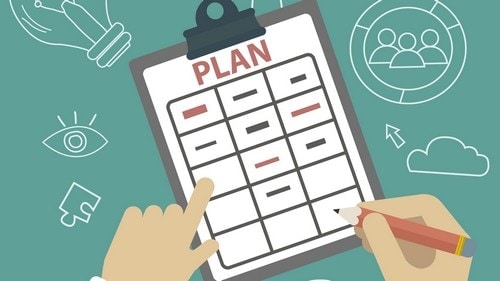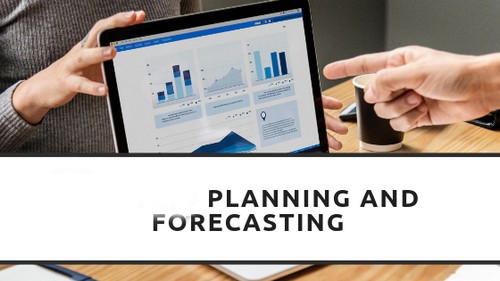Forecasting is the process of predicting what will happen in the future. It is based on past performance and current trends. Planning, on the other hand, is making plans for what you want to happen in the future.
People also plan based on how things have gone in the past, how things are going now, and what they think will happen. Forecasting and planning are important management tasks that are related to other tasks.
Predicting what might happen in the future based on how a company has done in the past or how it is doing now is an easy way to explain it. Conversely, planning means thinking about what you should do in the future before you do it.
The main differences between forecasting and planning are explained in this piece.
Table of Contents
What is forecasting?
Forecasting is analyzing and clarifying the future state regarding the operations you plan to undertake. In the process of forecasting, information from both past and present and facts are taken into consideration to foresee future events. Therefore, we can say that forecasting helps us look at past and present performance and forward to predetermining trends and events of the future and their possible impacts on the organization.
Managers working at different levels of an organization perform forecasting. In addition to this, sometimes experts like economists, analysts, and statisticians have also performed forecasts for the organization to forecast future uncertainties. Forecasting is of two types –
Quantitative Forecasting Method
Different types of quantitative forecasting methods are –
- Extrapolation
- Time Series Analysis
- Regression Analysis
- Econometric Analysis
Qualitative Forecasting Method
A qualitative method can be of the following types –
- Consumer Surveys
- Delphi Method
- Executive Opinion
Other types of forecasting are critical forecasting, time series forecasting, and naive forecasting. In naive forecasting, you use the real data from the previous period as the forecast for future event in the current period without making any changes or considering what caused what. Judgmental predicting methods use gut feelings, personal beliefs, and estimates of how likely something will happen.
Time series forecasting looks at patterns seen in the past to guess what will happen in the future over a length of time. It is based on the idea that future trends will follow patterns seen in the past. Forecasting plans like these are based on past trends observed over a while. They include plans for both forecasting the present and the future.
No forecasting method can give you a 100% correct picture of the future. There is always some guesswork involved, which raises the risk of making a mistake.
Purpose of Forecasting
Forecasting is trying to guess what changes, trends, or unforeseen eventswill happen. It gives businesses the information they need to make plans and take actions that will lead to the results they expect. Forecasts help businesses figure out what their customers want, improve the quality of their products, keep an eye on their stock levels, divide up their assets, and check their financial health. Forecasting, then, is a way to think ahead about how to deal with future changes and lower risks.
Process of Forecasting
Usually, the following steps make up the process of forecasting:
- Putting together old records: In this step, you will get the information you need from past deals, field surveys, or sector analyses.
- Scrutinizing cycles and connections: It involves recognizing recurring themes, interrelations, or periodicities in the data to derive meaningful insights and relationships.
- Figuring out predictive approaches: This step involves choosing the right models for the data type and the forecast goal.
- Trying to make predictions: Using the models to guess what will happen or how things will turn out.
- Checking and improving predictions: In this last step, we compare the predictions to real events to determine their accuracy and make changes as needed.
Instead of using weather forecasts as an example, consider how predictive analytics could determine the demand patterns for new eco-friendly backpacks based on reports of how people act online and environmental trends. This real-life example shows the usefulness and adaptability of predicting methods.
What is Planning?
One of the most basic things managers do is plan. Planning helps them determine what, when, and how something should be done. When you plan, you choose a course of action to complete a certain task in the future. It is a deep, goal-oriented, and all-encompassing exercise.
Planning means making plans for what you want to happen in the future and then using facts to figure out what you need to do to get there. This can help you reach your goal and improve your chances of success. Planning can set expectations, assign duties, and give direction, ensuring everyone knows what their part is in the process.
By connecting the present and future, planning helps the company link with the world around them in the future. Planning means planning for what you will do in the future and how you will get there. Important facts and information about future environment are gathered and studied when planning, and decisions and choices about where to go are made based on the plan.
Planning is based on being able to look ahead and peek into the future so that you can prepare for what might happen in the future. This planning process helps organizations set up resources to meet future goals and exploit new possibilities.
Purpose of Planning
Planning is important in setting goals and organizational objectives and determining the best ways to reach them. It includes having goals, making plans that can be implemented, distributing resources responsibly, and making schedules with important checkpoints. This process allows businesses to make clear decisions, coordinate their efforts, assign tasks, and monitor progress. It ensures that projects are well-thought-out, focused, and designed to get the desired results.
Process of Planning
Before you can start planning, you need to do these important things:
- Setting targets means writing down clear goals that a business wants to reach.
- Looking at how things are now: Looking into the internal and external environments to discover their strengths, weaknesses, chances, and threats.
- Crafting Strategies: Coming up with a set of plans or strategies to reach the goals that have been set.
- Giving Out Resources: Finding the resources, like money, people, and technology, that are needed to carry out the plans effectively.
- Establishing deadlines and standards: Set clear deadlines, stop points, and goals to track progress and encourage responsibility.
- Execution and Oversight: Implement the suggested actions, monitor progress, and change strategies as needed.
Take the example of a tech startup that wants to get a bigger part of the market. Setting goals could mean deciding on a certain percentage growth in the number of users from one year to the next. When judging the current situation, one could look at the competitors and the amount of user engagement. Some crafting tactics include adding new features to products and starting advertising campaigns.
Assigning resources could include setting budgets for marketing and development and giving dates for when products will be released and campaigns will start. Then, updates and marketing campaigns would be rolled out, and strategies would be changed all the time based on feedback from the market and success metrics.
Comparison Chart Planning vs Forecasting
| PLANNING | FORECASTING |
|---|---|
| Planning is looking into the planned course of action for the future organization and preparing for different departments accordingly. | Forecasting is a process of predicting the performance of an organization in the future based on its performance in the past and present. |
| Planning is based on pertinent information, objectives, and forecasts. | Forecasting is based on assumptions and speculations, which require a certain degree of guessing. |
| It is concerned with assessing the future and preparing for it. | It is concerned with approximating future events and trends. |
| Planning stresses on expectations and facts. | Forecasting stresses on facts only. |
| It is the responsibility of top level of managers. | It is the responsibility of managers at different level and also experts of different departments. |
Key Differences Between Forecasting and Planning
Forecasting based on past data can provide valuable insights and help anticipate upcoming market trends. However, forecasting is not a replacement for planning – it requires the use of planning to develop strategies for achieving goals. Planning is essential to create a roadmap and anticipate the future, whereas forecasting can only provide insight into what may happen. Some of the notable differences between forecasting planning are given below –
- Planning is breaking down goals into actionable steps and outlining a roadmap. On the other hand, forecasting predicts future performance based on past and present data.
- Planning decides the best path forward, usually on a long-term timeline. Forecasting is used to predict future performance from both past and current performance.
- Planning is based on expected results, while forecasting uses past performance data to build a model for estimating future performance.
- Planning is a proactive process that requires strategy and an understanding future trends. Forecasting is a reactive approach that relies on past numerical data and existing trends to estimate future action.
- Planning is setting goals, making decisions, and acting based on those decisions. Forecasting, however, estimates future events using personal opinion-based forecasting or historical data.
- Forecasting is not completely accurate as it relies on assumptions and estimations. Conversely, planning takes into account forecasting, relevant current data, and the organization’s objectives.
- Planning is essential for financial planning, while forecasting is more helpful in predicting future trends and actions. Planning implies a goal or purpose, while forecasting is more about predicting future outcomes.
Conclusion
Planning and forecasting require specific abilities, such as farsightedness, reflective and strategic thinking, experience, decision-making, and imagination. Top-level managers are responsible for performing these challenging tasks efficiently and effectively. Therefore, top management must have these abilities to shape a firm’s future. Forecasting is also an essential part of the planning process because a huge part of planning relies on the forecast’s outcomes. For example, financial analysts must use planning and forecasting to meet the organization’s objectives.
FAQs
What sets forecasting apart from planning?
Forecasting is guessing what might happen next, and planning is making a list of steps to reach your goals.
Is it possible to plan without projecting future trends?
It is possible to plan without seeing what the future holds clearly. However, forecasts can help by giving important details and numbers that make planning easier.
Does planning and forecasting rely on time limits?
Yes, planning and predicting involves estimating future event, the time it will take and making decisions or predictions based on what you think will happen in the future.
Is forecasting mainly centered on analyzing data compared to planning?
Predicting emerging trends usually involves looking at past trends, analyzing data, and using statistical methods. Planning, on the other hand, includes a wider range of tasks, such as setting goals, allocating resources, and making a plan for how those goals will be met.
Do forecasting and planning need to happen more than once?
Yes, forecasts and planning usually involve reviewing things repeatedly to ensure accuracy and incorporate new information or changes.
Liked this post? Check out the complete series on Marketing


it is so simpal to learn